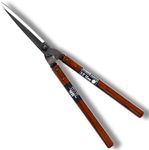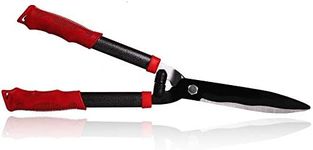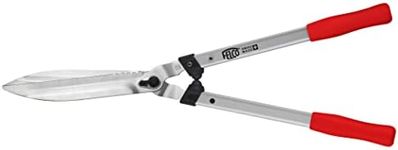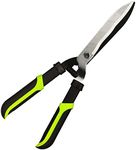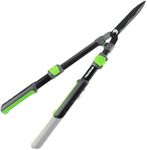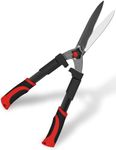Buying Guide for the Best Hedge Shears
When choosing hedge shears, it's important to consider several key specifications to ensure you get the best tool for your gardening needs. Hedge shears are essential for maintaining the shape and health of your hedges, shrubs, and bushes. The right pair can make your gardening tasks easier and more efficient, while the wrong pair can lead to frustration and poor results. Here are the key specifications to consider when selecting hedge shears and how to choose the best fit for you.Blade MaterialThe blade material is crucial because it affects the durability and sharpness of the shears. Common materials include stainless steel, carbon steel, and non-stick coated blades. Stainless steel blades are resistant to rust and easy to maintain, making them a good choice for general use. Carbon steel blades are very sharp and durable but require more maintenance to prevent rust. Non-stick coated blades help reduce sap and debris build-up, making them easier to clean. Choose a blade material based on your maintenance preference and the type of plants you will be trimming.
Blade LengthBlade length determines the reach and precision of your cuts. Shorter blades (6-8 inches) offer better control and are ideal for detailed trimming and shaping. Medium blades (8-10 inches) provide a balance between control and reach, suitable for general hedge maintenance. Longer blades (10-12 inches) allow you to cover more area quickly, making them perfect for large hedges. Consider the size of your hedges and the level of detail required when choosing the blade length.
Handle Length and MaterialHandle length and material impact comfort and leverage. Shorter handles offer better control but less leverage, while longer handles provide more leverage for cutting thicker branches but can be harder to maneuver. Handle materials include wood, aluminum, and fiberglass. Wooden handles are sturdy and provide a traditional feel but can be heavier. Aluminum handles are lightweight and resistant to rust, making them easy to handle. Fiberglass handles are durable and absorb shock well, reducing hand fatigue. Choose handle length and material based on your comfort, strength, and the type of hedges you will be trimming.
WeightThe weight of the hedge shears affects how long you can use them without fatigue. Lighter shears are easier to handle and reduce strain on your arms and shoulders, making them suitable for extended use. Heavier shears may provide more cutting power but can be tiring to use for long periods. Consider your physical strength and the duration of your trimming tasks when selecting the weight of your hedge shears.
Cutting MechanismThe cutting mechanism can influence the ease of use and efficiency of the shears. Traditional manual shears require physical effort to operate, making them suitable for smaller tasks and those who prefer a hands-on approach. Ratcheting shears have a mechanism that multiplies the cutting force, making it easier to cut through thicker branches with less effort. Choose a cutting mechanism based on the thickness of the branches you will be trimming and your physical strength.
Adjustable TensionAdjustable tension allows you to customize the tightness of the blades, which can improve cutting performance and reduce hand fatigue. This feature is particularly useful if you will be trimming different types of plants with varying branch thicknesses. Look for shears with an easy-to-use tension adjustment mechanism to ensure you can quickly adapt to different trimming tasks.


